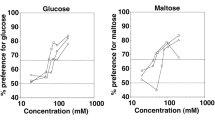Summary
Advantage was taken of the ability to systematically manipulate consumption rate in the slugAriolimax to quantitatively characterize the factors affecting the short-term control of food intake.
-
1.
The rate at whichAriolimax consumes an agar-based food was found to be inversely related to the food's hardness (Fig. 3) which is determined by its agar concentration (Fig. 2).
-
2.
Under conditions in which food intake is restricted by feeding slugs hard agar-foods, meal duration and size were observed to be monotonically related to the chemostimulant intensity of the food (Fig. 5).
-
3.
Agar-foods having similar chemostimulant concentrations but consumed at faster rates, were associated with a significant increase in meal size (Fig. 6A) and a concomitant reduction in meal duration (Fig. 6A). The reduction in meal duration was highly correlated (r=0.99) with the increase in meal size (Fig. 6B).
-
4.
Bite frequency was not significantly effected by either food hardness or increased meal volumes (Fig. 7).
-
5.
A “Feeding Equation” was derived from the empirical data. The equation was shown to be capable of predicting meal durations to a reasonable degree of accuracy over a range of chemostimulant concentrations and food hardness (Table 1, Fig. 8).
The accuracy of the Feeding Equation implies that two processes are necessary and sufficient to account for the short-term control of food intake inAriolimax. It is suggested that these two processes may be sensory adaptation and post-ingestional feedback. The significance of these findings for future neurobehavioral studies of taste-aversion learning in terrestrial slugs is discussed.
Similar content being viewed by others
References
Blaney, W.M., Duckett, A.M.: The significance of palpation by the maxillary palps ofLocusta migratoria (L): an electrophysiological and behavioral study. J. exp. Biol.63, 701–712 (1975)
Cates, R.G.: The interface between slugs and wild ginger: some evolutionary aspects. Ecology56, 391–400 (1974)
Cates, R.G., Orians, G.H.: Sucessional status and the palatability of plants to generalized herbivores. Ecology56, 410–418 (1975)
Dethier, V.G.: Adaptation to chemical stimulation of the tarsal receptors of the blowfly. Biol. Bull.103, 178–189 (1952)
Dethier, V.G., Evans, D.R., Rhoades, M.V.: Some factors controlling the ingestion of carbohydrates by the blowfly. Biol. Bull.111, 204–222 (1956)
Fromming, E.: Über die Nahrung vonLimax (Heynemannia) maximus. Anz. Schädlingsb.25, 41–43 (1952)
Gain, W.A.: Notes on the food of some of the British mollusks. J. Conchology6, 349–361 (1891)
Gelperin, A.: Stretch receptors in the foregut of the blowfly. Science157, 208–210 (1967)
Gelperin, A.: Rapid food-aversion learning by a terrestrial mollusk. Science189, 567–570 (1975)
Gelperin, A., Forsythe, D.: Neuroethological studies of learning in mollusks. In: Simpler networks: an approach to patterned behavior and its foundations (ed. J.C. Fentress). Sunderland, Massachusetts: Sinauer Associates 1976
Grime, J.P., Blythe, G.M., Thornton, J.D.: Food selection by the snailCepaea nemoralis. In: Animal populations in relation to their food resources (ed. A. Watson). British Ecol. Soc. Symp. N.10, 73–99 (1970)
Ingram, W.M., Hand, C.: Feeding ofAriolimax columbianus (Gould) on the California Bay Fruit. Nautilus62, 131–135 (1949)
Kupfermann, I., Carew, T.J.: Behavioral patterns ofAplysia californica in its natural environment. Behav. Biol.12, 317–337 (1974)
Mpitsos, G.J., Collins, S.: Learning: rapid aversive conditioning in the gastropod molluskPleurobranchaea. Science188, 954–957 (1975)
Mpitsos, G.J., Davis, W.J.: Learning: classical and avoidence conditioning in the molluskPleurobranchaea. Science180, 317–320 (1973)
Senseman, D.M.: Gastropod molluscs as model systems for the study of integrative mechanisms controlling feeding behavior. In: The chemical senses and nutrition. Vol. 2 (ed. M. Kare). New York and London: Academic Press 1977a
Senseman, D.M.: Starch: a potent feeding stimulant for the terrestrial slugAriolimax californicus. J. chem. Ecol.3, 701–715 (1977b)
Susswein, A. J., Kupfermann, I., Weiss, K.R.: The stimulus control of biting inAplysia. J. comp. Physiol.108, 75–96 (1976)
Van Der Starre, H.: Tarsal taste discrimination in the blowfly,Calliphora vicina Robineau-Desvoidy. Neth. J. Zool.22, 227–282 (1972)
Author information
Authors and Affiliations
Additional information
I would like to thank Drs. Alan Gelperin and Vincent Dethier for valuable assistance in the design and execution of the experiments described above and Dr. Gary Beauchamp for critical reading of this manuscript. This research was supported by a predoctoral fellowship from the Spencer Foundation.
Rights and permissions
About this article
Cite this article
Senseman, D.M. Short-term control of food intake by the terrestrial slugAriolimax . J. Comp. Physiol. 124, 37–48 (1978). https://doi.org/10.1007/BF00656389
Accepted:
Issue Date:
DOI: https://doi.org/10.1007/BF00656389




